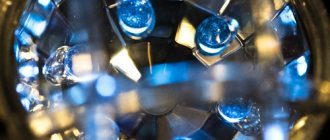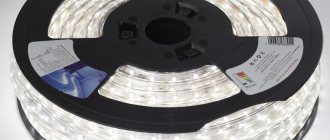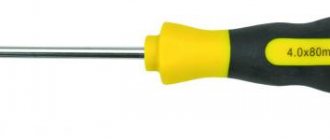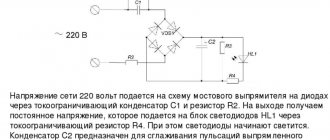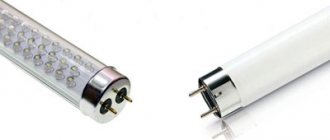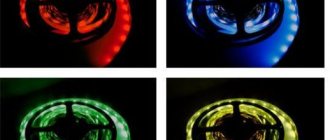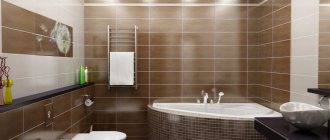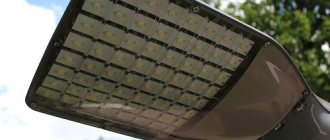Considering that we most often start planting sprouts in January, when daylight hours are especially short, additional lighting is rule No. 1. It is necessary in the morning and evening hours. Pay especially attention to this issue if your windows face north or you live on the ground floor. But modern phyto-lamps are so expensive that, combined with the costs of a greenhouse, such vegetables then turn out to be “golden”. Haven’t you really been able to cope without modern technical innovations before? And what can you build in your home workshop? In fact - a lot, but it’s important to first understand such concepts as “spectrum”, “cone” and “LEDs”. So, let’s make lighting for seedlings with our own hands!
- 2 About the “necessary” and “unnecessary” spectrum
- 3 Which type of lamps should you prefer?
- 4 We design LED backlighting ourselves
- 5 How to check if the light is correct?
Check the spectrum of diodes in the phytolamp
It is well known that plants require sunlight, consisting of waves of different lengths and colors, to grow and develop. In the spring, during the period of growing seedlings, when there is not enough sunlight, artificial lighting lamps are usually used to illuminate the plants. However, their emission spectrum is limited and occurs mainly in the yellow and green color sectors. In addition, incandescent lamps consume a lot of electricity. Fluorescent and modern energy-saving lamps are more economical, but emit little light in the red and orange spectral regions. And plants respond well with response growth to blue and red colors.
This optimal combination of colors was achieved by using LEDs in phytolamps. Therefore, these lighting sources are called bicolor. To choose the right lamp, you need to look at the so-called spectrogram (see Figure 1). It is also on the packaging of the lamp itself. The spectrogram should have peaks in the blue and red sectors of the spectrum. In the blue sector, the optimal wavelength for seedlings is 440-450 nm, and in the red sector – 650-660 nm. If the spectral indicators deviate strongly in both directions, such a lamp is not worth buying, since waves of other lengths are ineffective for seedlings.
Picture 1
Characteristics of light
When growing plants indoors, the power of lamps to accelerate photosynthesis is not of great importance. Particular attention should be paid to the spectrum of devices and their similarity to natural sunlight. A light beam can have one stream or include several waves of a certain length at once. The following colors from the spectrum have a characteristic effect on plants:
- Blue, purple. They influence the development of the crop, accelerate the growth of greenery, roots, form the splendor of the crown, and new shoots. Stimulation with such rays leads to the production of proteins. The lighting is suitable for winter. Wavelength – 380-490 nm.
- Yellow. Does not have much effect on seedlings. Tall crops quickly stretch out, as if there is a lack of lighting, and have poorly developed leaf apparatus. Wavelength – 565-595 NM.
- Red, orange. The process of photosynthesis is started thanks to these flowers. You can regulate the growth rate of crops by changing the illumination intensity. Red rays speed up germination, orange rays increase fruiting. Wavelength – 600-750 nm.
- Green. Pulls out stems very quickly. They do not have time to get stronger, become thinner and fall to one side. Leaves are formed only in the upper part of the crop. Wavelength – 490-565 NM.
- Ultraviolet. Controls growth and allows timely production of necessary vitamins. Radiation develops immunity to external influences (temperature changes). Wavelength – 280-380 nm.
Distinguish between real and rated diode power
Diodes come in different powers - 1 W, 3 W or 5 W. For the needs of a “home greenhouse,” the most suitable are emitter lamps with a primary lens that scatter light at an angle of 120 degrees. A 3 W lamp with the correct ratio of emitted light and heat is considered optimal.
In order not to make a mistake when choosing a lamp, you need to distinguish between the concepts of nominal and real power. Let's figure out what they mean. Rated power is the power at which the diode operates at its maximum limit. This means that the “life” of the diode under such a load will be short. To make diodes last longer, they are “powered” at half their power, that is, a 3 W diode will actually “show” 1.5 W. This is its real power. Self-respecting manufacturers of LED lamps are required to indicate this information on their websites (see Figure 2).
Figure 2
Correctly calculate the power of the LEDs in the lamp
How to calculate the total power of LEDs? How many diodes should there be in a lamp? The answer to these questions depends on your specific situation. The most important thing in the choice is the relationship between the diode and the radiator (more on this in paragraph 6).
The formula for calculating the number of diodes is quite simple: M = K × M1 , where M is the total power of the lamp (W), K is the number of diodes, and M1 is the power of one diode. However, not all manufacturers are completely honest with customers. In order not to fall for the bait, we will close the gap in knowledge.
Let's say you choose a lamp with a power of 54 W and 18 diodes from Aliexpress, where the manufacturer claims that the power of each diode is 3 W. If you measure it with a wattmeter (a device for measuring the power of connected devices), it turns out that it produces 11 W.
It must be taken into account that the diode cannot operate at maximum for a long time! So, let's calculate: 54 W divided by 18 diodes, we get 3 W for each diode, which work at full capacity! But this cannot be! However, you are paying for 54 watts of rated power and 27 watts of actual power (see information above.) But when measured, it produces 11.6 watts. This is a far cry from 27W.
The real output of the diode is half the power. Then if we take 1.5 W of the power of each diode and multiply it by 18 diodes, we get that this lamp should consist of at least 27 diodes, and not 18, as it actually is. Deception? No, it’s just that there are diodes of lower power, that is, 1 W, which operate at half their power. Manufacturers, of course, do not write about this.
But how did this happen? We take 11.6 W of real power from the outlet, divide it into 18 diodes. And we get 0.64 W! That is, 0.64 W is almost half of 1 W.
Now we take the Minifermer.ru lamp. The packaging says that the lamp consists of 12 diodes with a power of 3 W - in total this is 36 W, that is, the real power from the outlet should be 15-18 W. This is true!
This means that the lamp contains exactly 3-watt diodes! They will work for a long time, and at the same time you will get good results. So the information for the lamp must indicate both the rated power and the real one.
Consider the radiator area
The radiator is an aluminum housing, which in base lamps is located in a circle or, if it is a linear lamp, the entire housing is the radiator. In Figure 3, the radiator is indicated by arrows.
Figure 3
The heatsink is designed to disperse the heat produced by the diodes. Therefore, the volume of the radiator must be designed for the number of diodes so that they do not overheat. The maximum temperature on the diode crystal should not exceed 70-75°C, otherwise they will “degrade”. That is, if there are many diodes in a lamp and the radiator is small, such a lamp will quickly fail.
Figure 4
In order for the LED phytolamp to work properly, the ratio between the radiator area and the number of diodes must be well adjusted. The distance between the diodes is equally important, that is, if there is enough space between the diodes, the heat is distributed faster. An example of the correct “fitting” of diodes on a radiator is shown in Figure 4.
You can find out detailed information about LED phytolamps from the following video:
Consider the distance from the lamp to the illumination area
At what distance from plants should phytolamps be placed? The answer to this question will depend on the room and how many plants you plan to grow, as well as the length of daylight hours.
| Real lamp power | Distance to plants | Area coverage (diameter) |
| 7-10 W | 20-30 cm | 25-30 cm |
| 10-15 W | 35-40 cm | 45-50 cm |
| 15-20 W | 40-45 cm | 85-90 cm |
To ensure that the lamp retains its functions and the effect of such lighting does not decrease, it can be equipped with additional lenses in order to narrow the beam of light. The area of illumination will depend on the selected lenses. In order not to overpay for extra lamps and unnecessary power, it is better to select them with the help of professionals.
Calculation of the required level of illumination
Properly selected LED lighting for plants will allow pets to develop normally and delight their owners with their beautiful appearance.
When making calculations it is necessary to take into account:
- type of indoor flower;
- distance from the lamp to it;
- the area to be illuminated.
Important! When placing the light source above the plants, there is no loss of light flux. So, when the lamps are at a height of 0.3 m, approximately 30% of the flux will be lost.
Lamp at a height of 30 cm from the flowers
Illumination refers to the amount of luminous flux (in lumens) falling per square meter of base.
For example, you need to calculate the required number of lamps to illuminate a shelf with flowers 1 m long and 30 cm wide. The structure area will be 0.3 m2. To create an illumination of 5 thousand lux, you will need light sources with a luminous flux of 1500 lm. Considering the 30 percent loss, it is necessary to create a flow reserve. Thus, the required amount of luminous flux will increase to 1950 lm.
The luminous efficiency of various light sources is known. Knowing them, it is not too difficult to calculate the lamp power required to organize the lighting.
Light output indicators of various light sources
- Standard incandescent lamps. They have a light output of about 12 - 13 lm/W. The power that the light sources should have is determined: 1950 divided by 12, it turns out 162.5 W. To provide the required illumination, you will need 3 lamps of 60 W each.
- Luminescent sources. The lamps have a light output of 65…70 lm/W. Accordingly, the power of the lamps should be 30 W. To illuminate plants, you can limit yourself to two 15 W lamps.
- LEDs. Their light output is approximately 100 lm/W. Such light sources should provide a power of 19.5 W. You can take 3 lamps of 7 W each.
But it should be taken into account that the calculations were made when installing lighting at a height of 30 cm above the flowers. If the distance is greater, losses will increase significantly.
Dependence of illumination on the height of the lamp
Consider installing additional lenses
As mentioned earlier, the diodes already have a primary lens and an illumination angle of 120 degrees. But if you hang the lamp too high, less light will reach the plants and it will be more scattered. That is, the light will cover an unusable area. This use is ineffective, but you will have to pay extra for electricity. Installing additional lenses will help solve this problem. They come in 15, 30, 45, 60, 90 degrees. Selecting a lens will make it possible to choose the desired height and maintain the useful lamp power needed by the plants.
Video about the practice of using phytolamps for growing plants:
1) Forums and demagoguery. What surprised me most was the communication on the forums. There, 90-95% of people who have not even tried LEDs are trying to claim something (that they are better or worse), in fact there were several people who tried them. Everything else is empty chatter, theoretical arguments, misconceptions, flood... The conclusion so far is this: if you don’t want to get confused and get misinformation, don’t read the forums. For example, many people think that they can use a lux meter to compare different types of lamps for their effectiveness in illuminating plants. No! A lux meter can only compare the same types of lamps and more for other purposes. It does not give an idea of the spectral properties of the light from the phytolamp! Oh, these forums... There are almost no people there who really understand and who have at least tried something! By the way, I once came across a report with a photo of a family who tried LEDs, the results were average, but the problem is that they were sold cheap low-power LEDs of the wrong class for a significant amount. In short, their sellers deceived them. Such as they had - they had to be placed close to the plants.
Select a lamp of the desired spectrum
Bicolor spectrum - the main spectrum for giving the plant the energy necessary for photosynthesis. A lamp with this spectrum is recommended:
- for illuminating any plants on the windowsill, balcony and in places with minimal sunlight;
- for growing seedlings and young plants;
- for additional illumination of adult plants indoors with additional light sources;
- to support plants in winter and in low light conditions.
Full spectrum. These are bicolor lamps with a wider range of peaks in the red and blue fields. They are universal and will suit many plants. In terms of energy efficiency and spectrum peaks, these light sources are slightly inferior to bicolor lamps, but due to a wider spectral zone they allow the plant to receive maximum artificial light, similar in effect to solar light.
There are more advanced lamps - these are full-spectrum lamps with the addition of white light. They are suitable for use in places where people live. The light from such a lamp looks warm white, but contains wavelengths useful for plants.
Multicolor spectrum is a unique lamp that combines red, blue, warm white and far red light. It provides maximum stimulation of flowering and fruiting in many plants, including orchids and adeniums, as well as a large proportion of red and blue light for photosynthesis during the growth stage. A lamp with this spectrum is recommended:
- for illuminating adult plants;
- to stimulate flowering and fruiting;
- for growing indoors in the absence of sunlight;
- for additional illumination of indoor flowers, especially orchids;
- for illuminating decorative foliage plants.
The average recommended time for additional illumination with phytolamps is 13-14 hours a day. These lamps can be used not only to extend daylight hours, but also to replace it in a dark room. At night, plants take a break because, like humans, they have a biological clock, and they need “sleep” at night.
Peppers, tomatoes, eggplants, and cucumbers are recommended to be illuminated for 8 to 13 hours a day. Green crops (salads) - 8-11 hours a day, slow-growing plants (celery, radishes, turnips) - 12-16 hours a day.
How to make seedling lighting with your own hands
To provide additional lighting above the seedlings, you need some kind of structure to which lighting fixtures can be hung or attached. This video shows how you can make such a stand using simple materials at hand.
When there are a lot of seedlings, but there are few windows, or some of them are cold, you can build a backlit rack to save space. How to do this, watch the video. To summarize what has been said, it should be noted that now few people grow seedlings the old fashioned way, simply by placing boxes on the windowsill. Experienced gardeners try to extend daylight hours for plants and use various lamps for this. But both the quality and potential of plants depends on correctly selected lighting. And if you follow all the rules, light feeding will serve as an additional guarantee that the seedlings will eventually grow strong, healthy and will be able to move to a new place without any problems.
Have a good harvest!
Buy phytolamps with a guarantee
This is a very important point. Manufacturing companies and conscientious sellers must issue a warranty for the lamp. It is very important. If you buy a lamp from an unverified seller, you will not be able to prove to him that it failed not through your fault, but, for example, due to a power surge. And not everyone will undertake to repair such a lamp. Therefore, choose LED bulbs that come with a minimum 1-year warranty.
Some companies, including Minifermer.ru, offer post-warranty service, which is also important. After all, if one diode fails, it will be replaced immediately. And you don't have to figure out which diode is needed and how to solder it.
If you are an avid summer resident who is used to “preparing the cart in winter,” take care of the future harvest now. With lamps from the Minifermer.ru company, your seedlings do not face a lack of light and heat on the windowsill.
